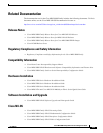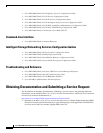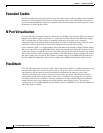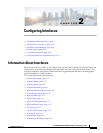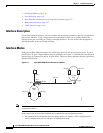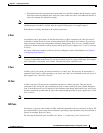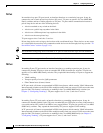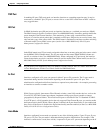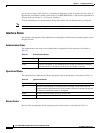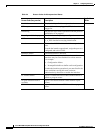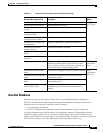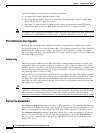
2-3
Cisco MDS 9000 Family NX-OS Interfaces Configuration Guide
OL-29284-01, Release 6.x
Chapter 2 Configuring Interfaces
Information About Interfaces
• The operational status represents the current status of a specified attribute like the interface speed.
This status cannot be changed and is read-only. Some values may not be valid when the interface is
down (for example, the operational speed).
Note When a module is removed and replaced with the same type of module, the configuration is retained. If
a different type of module is inserted, then the original configuration is no longer retained.
Each interface is briefly described in the sections that follow.
E Port
In expansion port (E port) mode, an interface functions as a fabric expansion port. This port may be
connected to another E port to create an Inter-Switch Link (ISL) between two switches. E ports carry
frames between switches for configuration and fabric management. They serve as a conduit between
switches for frames destined to remote N ports and NL ports. E ports support class 2, class 3, and class
F service.
An E port connected to another switch may also be configured to form a PortChannel (see Chapter 6,
“Configuring PortChannels”).
Note We recommend that you configure E ports on 16-port modules. If you must configure an E port on a
32-port oversubscribed module, then you can only use the first port in a group of four ports (for example,
ports 1 through 4, 5 through 8, and so forth). The other three ports cannot be used.
F Port
In fabric port (F port) mode, an interface functions as a fabric port. This port may be connected to a
peripheral device (host or disk) operating as an N port. An F port can be attached to only one N port. F
ports support class 2 and class 3 service.
FL Port
In fabric loop port (FL port) mode, an interface functions as a fabric loop port. This port may be
connected to one or more NL ports (including FL ports in other switches) to form a public arbitrated
loop. If more than one FL port is detected on the arbitrated loop during initialization, only one FL port
becomes operational and the other FL ports enter nonparticipating mode. FL ports support class 2 and
class 3 service.
Note FL port mode is not supported on 4-port 10-Gbps switching module interfaces.
NP Ports
An NP port is a port on a device that is in NPV mode and connected to the core switch via an F port. NP
ports function like N ports except that in addition to providing N port operations, they also function as
proxies for multiple, physical N ports.
For more details about NP ports and NPV, see Chapter 7, “Configuring N Port Virtualization.”



